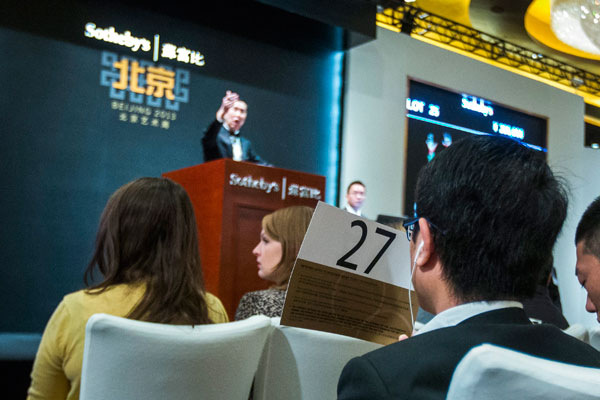Cheap imitations of Chinese art have also started to flow from China to the European markets, where they become pricy art pieces that are later resold to wealthy Chinese buyers.
"My concern is that the inflow of fakes will dilute the overall quality of the European market and drive down prices," says Wang Yudong, an art expert and general manager of Beijing Gehua Art Co, a State-owned firm and local partner of global auction house Sotheby's.
"If this becomes a trend, it will hurt the authenticity of the European market and it will be the collectors who will eat the bitter fruits in the end."
But some experts feel it is still too early to say if the market has peaked because the number of high-quality Chinese artworks is dwindling in Europe, something that could trigger more price rises.
"The market is living on the existing pieces, the number of which is decreasing because many of them are going to Asia," Delalande says. "The scarcity of high-quality works means that the price will continue to rise while there will be more money and stronger demand from the rich Chinese buyers."
Although New York regained its position from Beijing as the leading global city in terms of art sales last year, many experts feel China will soon replace the US and Europe as the world's art trading center, given the size of its domestic sales and the international significance of its buyers.
 |
|
Sotheby's, partnered with Gehua Cultural Development Group, raised a total of $37 million in its auction in Beijing this month. Photo Credit / Goes Here
|
Changing paradigms
The art market has developed into a business worth more than $12 billion in terms of annual sales in China, a country where it barely existed 20 years ago.
Even though the Chinese art market has had the strongest growth, many experts feel it is still far from being a genuine art-trading center.
"China's art market is being pushed forward little by little. In fact the market is not fully prepared for such a status as far as the buyers, the operators and government policy are concerned," says Wang from Beijing Gehua Art Co.
Some experts say the sales figures at auction houses fail to reflect the real size of the Chinese art market because of the high non-payment rate. According to research by the European Fine Art Fair, up to 40 percent of the auction proceeds in the Chinese art market were unpaid or only partly paid.
Vellenga, the fair's representative, says: "If you deduct that percentage, the total sales in the art market of the Chinese mainland will not be No 1 because the non-payment rate at European and American auction markets is almost zero. So the US art market is still the strongest one," .
But the vast potential of the Chinese art market and the strong purchasing power of Chinese buyers are undeniable as the market gradually matures and more high-end institutional collectors are entering the market and view art as an effective way to better manage their investment portfolios.
We recommend:
